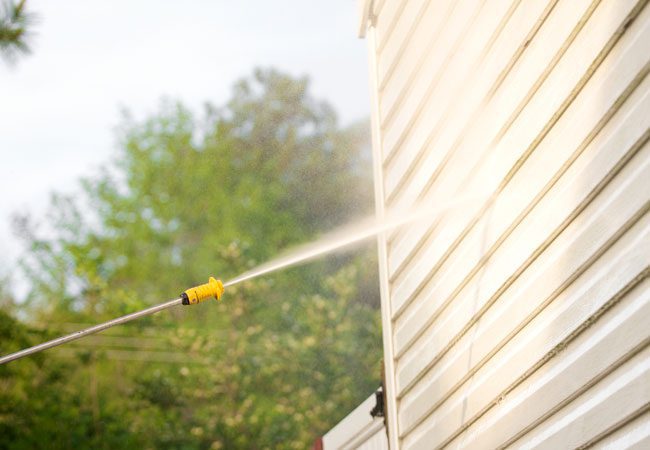Table Of Content

The power of your pressure washer is measured in PSI (Pounds per Square Inch) and GPM (Gallons Per Minute). A machine with a higher GPM is more powerful than a machine with more PSI and lower GPM. Regular pressure cleaning will remove grime and dirt and reveal imperfect areas that need your attention.
How often should you pressure wash your house?
To test pressure washers, including the models here, we evaluate how much pressure each model can produce. Those that generate a higher level of pressure (measured in pounds per square inch) receive a higher score than those with a lower pressure output. Whatever the material that’s being pressure-washed, make sure to prevent water from becoming trapped between the siding and your home’s sheathing because moisture promotes mold growth. Repair or replace loose, damaged, or missing siding, and take special care not to spray water directly into any gaps around doors, windows, or under the lap joints on siding runs. Don’t pressure-wash shingle siding—the pressure can knock the shingles loose. Check your owner’s manual to confirm which nozzle and setting the manufacturer recommends for decking, and how far away from the surface it should be held.
Ensuring Safety During Pressure Washing
The process is a terrific way to remove grime on your home’s traditional stucco, aluminum, steel, wood, and brick siding. Pressure washing can be performed every few years for general maintenance; it’s also necessary to prepare a home’s exterior before it is painted. Remember, pressure washing isn’t just pointing a hose at your house and spraying. It requires the right equipment, technique, and a bit of planning. Whether you choose a gas or electric model, the key is to use the right pressure settings and nozzles for your home’s specific needs. And always approach the task with safety in mind, protecting yourself, your home, and those around you.
Electric vs. gas pressure washer
Otherwise, doing it yourself or hiring a professional has its benefits and drawbacks—don’t forget to budget accordingly. Surfaces that can handle the warmer water can benefit from power washing, but it’ll cost homeowners more. On average, homeowners can expect to pay a professional $0.15-$0.75 per square foot. In summary, picking the right pressure washer and settings is about balancing power with precision. It’s about matching the tool to the task at hand, ensuring you clean effectively without causing damage.
Pressure Washer Safety
Pressure washers will remove loose paint, but they’re not a substitute for scraping. We’ll have to scrape additional loose paint after pressure washing this area anyway. Hold the wand with two hands and move it across the siding from side to side at a steady pace. From the siding, then move closer until you find the optimal cleaning distance. In general, work at a horizontal or slightly downward angle to avoid driving water up under the siding.
The higher the number, the wider the spray pattern, and the less concentrated (and potentially dangerous) the stream of water. Consumer Reports recommends against using a 0-degree nozzle because it poses an unnecessary safety risk. Water concentrated to such a fine point can pierce a range of surfaces, including protective boots. Concrete driveways (and walkways) can readily withstand a powerful cleaning without etching. Generally, a finer nozzle will be more effective at spot-cleaning grease stains.
UPDATE: Pressure washer scammer caught, victim gets help - ABC 36 News - WTVQ
UPDATE: Pressure washer scammer caught, victim gets help - ABC 36 News.
Posted: Fri, 04 Sep 2020 07:00:00 GMT [source]
Primes Surfaces
The pitch of your roof will also affect the cost—a steep pitch can add $0.10 per square foot to the price. Driveway sealing costs $400 to $800 total on average for 400 square feet. Driveway sealer not only helps protect the surface from natural elements, machine leaks, and other spills, it can also extend the life of your driveway and enhance your home's curb appeal. If you plan to paint the exterior, wait two to three days for the house to dry completely. Sweep the sprayer horizontally along the house, gradually moving from bottom to top. Use an extension pole for higher areas while keeping a downward angle.
Steps to Pressure Washing a House
Repair costs for small scrapes, dings, or other such damage are more manageable than major repairs or replacements. Layers of dirt and grime can hide details of your home’s exterior. You’re likely unable to see any damaged area of your house covered in dust.
Unfortunately, we cannot perform a background check on every employee of a business—the background checks are performed only on the owner or principal. As always, we recommend that you conduct your own research on the businesses you hire, including making inquiries directly with the businesses regarding their employee background check policies. As seen in Forbes, CNBC and USA Today, LawnStarter makes it easy to schedule service with a local lawn care professional.
The type of pressure washer you select can make a big difference in both the ease and effectiveness of the job. Let’s step into the world of pressure washing and start the journey to a cleaner, brighter home. To power-wash your porch, deck, driveway, or sidewalk, use a rotary surface-cleaner attachment—which looks like a frisbee and sprays water in a spinning motion—for fast and even cleaning. Direct the nozzle away from windows, holding the wand at an angle so you don’t drive water into joints, gaps or against the glass. Even so, check the sill on the inside and dry up any water that leaked through.
The high pressure can strip paint, dent siding, or even break windows if you’re not careful. You’ll want to remove this before painting to ensure the new paint adheres well. It’s similar to sanding down a piece of furniture before repainting it. If you’ve used detergent, make sure to rinse your house thoroughly. Any residue left behind can interfere with the new paint adhering properly. Think of it as preparing a canvas for painting; it needs to be clean and smooth.

No comments:
Post a Comment